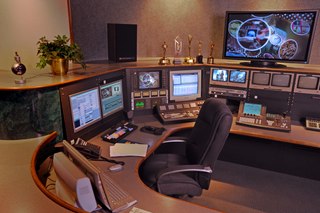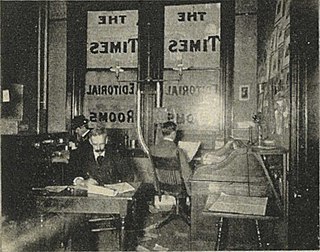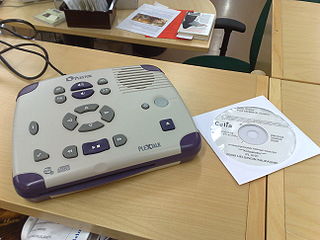This article has multiple issues. Please help improve it or discuss these issues on the talk page . (Learn how and when to remove these template messages)
|
VideoBook is a brand of online, interactive educational videos marketed by Studio 21.
This article has multiple issues. Please help improve it or discuss these issues on the talk page . (Learn how and when to remove these template messages)
|
VideoBook is a brand of online, interactive educational videos marketed by Studio 21.
The name "VideoBook" was first registered and used in the United Kingdom (UK) in 1982 by Barry R. Pyatt, the owner of Yorkshire film producers "Studio 21." VideoBook was the marque, trading title and style for local-interest and sell-through video films. The name VideoBook was in commercial use by Studio 21 in the UK and Spain until 2003. In 2004, Pyatt opened AngelFilms in Spain, which took over the VideoBook marque. In 2005, AngelFilms-UK was established, and in 2008, VideoBook products were re-launched in the UK.
VideoBooks are identified and registered with the ISBN agencies. The trademark style is as one word, with uppercase V and uppercase B, in a modified Bookman typeface, and is Pyatt's exclusive property.
The name "videobook" (without the two uppercase characters) has become a standard term for a form of online training that delivers downloadable training videos. Most video books are single website entities that focus on teaching a particular topic.
Video books are similar in content and structure to a "regular" book. The videos are typically recorded by a trained instructor and offered to the viewer on a subscription model. The user visits the video book (the website containing the training videos), purchases a subscription and can then download the videos.
Video Books are different from many computer-based training models in that they are typically in a shareable and portable format. They also differ in content delivery. Video Books are not to be confused with many Video Books or Video Booklets that companies like PrintAVizion, manufacturer for other businesses to promote services and products to prospecting clients. [1]
In contrast to printed books and audio books which rely solely on text and audio, respectively, the basic component of a videobook is video. The video book can have on-screen text along with pictures and video clips. The text may be animated along with related audio background commentary.
The student can watch videos in any order. Once downloaded, no Internet connection is necessary. The videos use non-proprietary formats. The target market is usually an individual instead of an organization. Videobook materials may involve presentation software such as PowerPoint, screen-capture software such as Camtasia and text-to-speech software, such as TextAloudMP3.
Paid Videobook (online, offline) - videobook online(offline) using the private information in the form of thoughts of a person registered on the Internet project has temporal properties: time, date, month, year of writing. Copyrights are registered online on authoritative sources confirmed. Payment for the information contained in the paid videobook takes place in credit, after reading it. [2]
Multimedia is a form of communication that uses a combination of different content forms, such as writing, audio, images, animations, or video, into a single interactive presentation, in contrast to traditional mass media, such as printed material or audio recordings, which feature little to no interaction between users. Popular examples of multimedia include video podcasts, audio slideshows, and animated videos. Multimedia also contains the principles and application of effective interactive communication, such as the building blocks of software, hardware, and other technologies.

Video editing software or a video editor is software used for performing the post-production video editing of digital video sequences on a non-linear editing system (NLE). It has replaced traditional flatbed celluloid film editing tools and analog video tape editing machines.

A website is a collection of web pages and related content that is identified by a common domain name and published on at least one web server. Websites are typically dedicated to a particular topic or purpose, such as news, education, commerce, entertainment, or social media. Hyperlinking between web pages guides the navigation of the site, which often starts with a home page. The most-visited sites are Google, YouTube, and Facebook.

Non-linear editing is a form of offline editing for audio, video, and image editing. In offline editing, the original content is not modified in the course of editing. In non-linear editing, edits are specified and modified by specialized software. A pointer-based playlist, effectively an edit decision list (EDL), for video and audio, or a directed acyclic graph for still images, is used to keep track of edits. Each time the edited audio, video, or image is rendered, played back, or accessed, it is reconstructed from the original source and the specified editing steps. Although this process is more computationally intensive than directly modifying the original content, changing the edits themselves can be almost instantaneous, and it prevents further generation loss as the audio, video, or image is edited.

Editing is the process of selecting and preparing written, visual, audible, or cinematic material used by a person or an entity to convey a message or information. The editing process can involve correction, condensation, organization, and many other modifications performed with an intention of producing a correct, consistent, accurate and complete piece of work.
Digital distribution, also referred to as content delivery, online distribution, or electronic software distribution, among others, is the delivery or distribution of digital media content such as audio, video, e-books, video games, and other software.
Offline editing is the creative storytelling stage of film making and television production where the structure, mood, pacing and story of the final show are defined. Many versions and revisions are presented and considered at this stage until the edit gets to a stage known as picture lock. This is when the process then moves on to the next stages of post production known as online editing, colour grading and audio mixing.

In computing, a news aggregator, also termed a feed aggregator, content aggregator, feed reader, news reader, or simply an aggregator, is client software or a web application that aggregates digital content such as online newspapers, blogs, podcasts, and video blogs (vlogs) in one location for easy viewing. The updates distributed may include journal tables of contents, podcasts, videos, and news items.

Avid Media Composer is a video editing application or non-linear editing system (NLE) developed by Avid Technology. It was initially released in 1989 as an offline editing system on the Macintosh II. Since the 1990s, Media Composer has been the dominant non-linear editing system in the high-end film and television industry, allowing offline and online editing workflows, including up to 16K editing and finishing. Much of its design, implementation, and terminology is derived from the people and practices found in filmmaking and broadcast.
Online editing is a post-production linear video editing process that is performed in the final stage of a video production. It occurs after offline editing. For the most part, online editing has been replaced by video editing software that operate on non-linear editing systems (NLE). High-end post-production companies still use the Offline-Online Editing workflow with NLEs.

Digital accessible information system (DAISY) is a technical standard for digital audiobooks, periodicals, and computerized text. DAISY is designed to be a complete audio substitute for print material and is specifically designed for use by people with "print disabilities", including blindness, impaired vision, and dyslexia. Based on the MP3 and XML formats, the DAISY format has advanced features in addition to those of a traditional audio book. Users can search, place bookmarks, precisely navigate line by line, and regulate the speaking speed without distortion. DAISY also provides aurally accessible tables, references, and additional information. As a result, DAISY allows visually impaired listeners to navigate something as complex as an encyclopedia or textbook, otherwise impossible using conventional audio recordings.

Sound on Sound is a monthly music technology magazine. The magazine includes product tests of electronic musical performance and recording devices, and interviews with industry professionals. Due to its technical focus, it is predominantly aimed at the professional recording studio market as well as artist project studios and home recording enthusiasts.

Subtitles are texts representing the contents of the audio in a film, television show, opera or other audiovisual media. Subtitles might provide a transcription or translation of spoken dialogue. Although naming conventions can vary, captions are subtitles that include written descriptions of other elements of the audio ,like music or sound effects. Captions are thus especially helpful to people who are deaf or hard-of-hearing. Subtitles may also add information that is not present in the audio. Localizing subtitles provide cultural context to viewers. For example, a subtitle could be used to explain to an audience unfamiliar with sake that it is a type of Japanese wine. Lastly, subtitles are sometimes used for humor, as in Annie Hall, where subtitles show the characters' inner thoughts, which contradict what they were saying in the audio.

A digital library is an online database of digital objects that can include text, still images, audio, video, digital documents, or other digital media formats or a library accessible through the internet. Objects can consist of digitized content like print or photographs, as well as originally produced digital content like word processor files or social media posts. In addition to storing content, digital libraries provide means for organizing, searching, and retrieving the content contained in the collection. Digital libraries can vary immensely in size and scope, and can be maintained by individuals or organizations. The digital content may be stored locally, or accessed remotely via computer networks. These information retrieval systems are able to exchange information with each other through interoperability and sustainability.

DVD-Video is a consumer video format used to store digital video on DVDs. DVD-Video was the dominant consumer home video format in Asia, North America, Europe, and Australia in the 2000s until it was supplanted by the high-definition Blu-ray Disc, before eventually both were replaced by streaming services such as Netflix and Disney+. Discs using the DVD-Video specification require a DVD drive and an MPEG-2 decoder. Commercial DVD movies are encoded using a combination of MPEG-2 compressed video and audio of varying formats. Typically, the data rate for DVD movies ranges from 3 to 9.5 Mbit/s, and the bit rate is usually adaptive. DVD-Video was first available in Japan on November 1, 1996, followed by a release on March 26, 1997 in the United States—to line up with the 69th Academy Awards that same day.

Home video is recorded media sold or rented for home viewing. The term originates from the VHS and Betamax era, when the predominant medium was videotapes, but has carried over to optical disc formats such as DVD and Blu-ray. In a different usage, "home video" refers to amateur video recordings, also known as home movies. Another format LaserDisc is also a home video format released in 1978 which never caught on market due to high cost of the players and their inability to record TV programs unlike the VHS. The format gained interests from movie collectors.
Creative Commons is maintaining a content directory wiki of organizations and projects using Creative Commons licenses. On its website CC also provides case studies of projects using CC licenses across the world. CC licensed content can also be accessed through a number of content directories and search engines.
Digital newspaper technology is the technology used to create or distribute a digital newspaper.

The following outline is provided as an overview of and topical guide to books: